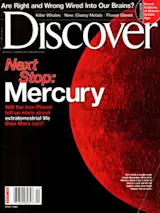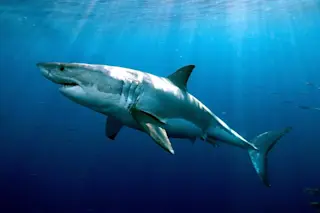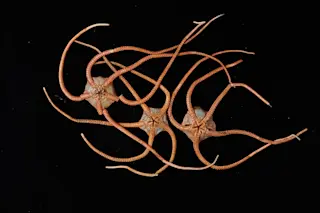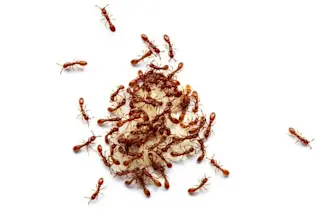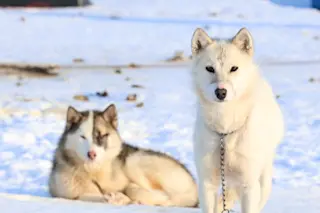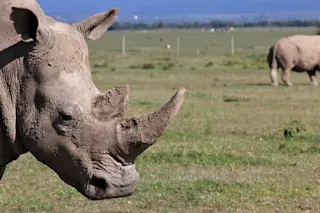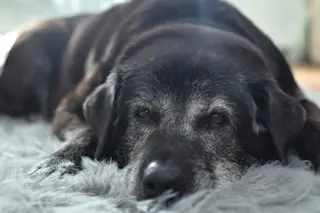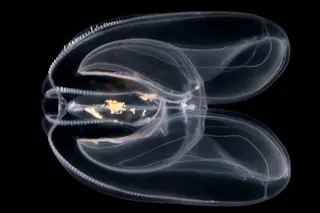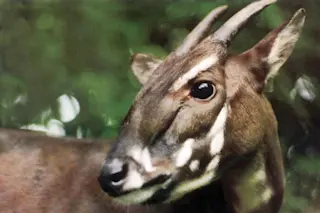The floor of the Silver Terrace Nursery in the San Francisco Flower Mart is crowded with buckets of long-stemmed roses. They come in more than 40 shades, a glorious sunset’s worth of reds, pinks, oranges, browns, yellows, and whites. And then, like a poke in the eye, there’s electric blue, the sort of color you’d see on a marching band uniform or a high school prom dress.
It’s a fake, of course—a white rose dipped in blue dye—but the nursery sells 75 a week. “They’re big for bar and bat mitzvahs,” says Silver Terrace’s owner, Robert Ruggeri. Not to mention graduations at the nearby University of California at Berkeley, whose colors are gold and blue.
Roses have been cultivated since before Christ in almost every size, shape, and color, yet breeders have never managed to create a blue rose. Sure, some varieties are marketed with names like ‘Blue Boy’ or ‘Blue Bell’, but as many a disappointed gardener can attest, the blossoms are invariably lavender or purple. A true blue bloom remains elusive and mythic—the Holy Grail of gardening.
“That’s just genetics,” says Randy Woodson, associate dean of agriculture at Purdue University in Indiana. Roses lack the gene that codes for blue pigment, he explains. Carnations, chrysanthemums, and gerberas are also blue-impaired, and other flowers have their own genetically limited palettes: There’s no such thing as a red iris, for instance, or a white marigold. Recently, however, biologists have begun to circumvent such limitations using the tools of biotechnology.
Plant geneticists are busy identifying dozens of stretches of DNA that help determine the size, shape, color, scent, flowering characteristics, and longevity of various plants. Yet floral bioengineering is barely out of the bud. Its efforts have focused on four areas so far: extending shelf life, developing new fragrances, restoring old ones (when’s the last time you could really smell a bouquet rose?), and breaking the color barrier. In 1986 an Australian company, now called Florigene (motto: “Smart flowers, better living”), decided to relaunch the ancient quest for a blue rose.
Their original plan seemed simple: Take the blue gene out of petunias and transfer it to roses, as well as to carnations and gerberas. But it wasn’t that easy. Experiments had shown that the gene produced a class of enzymes called cytochrome P450, of which there turned out to be hundreds of different forms. To find the right one, research director Edwina Cornish and her colleagues painstakingly extracted one P450-producing gene fragment after another and transferred the most promising ones to petunias lacking the gene. It wasn’t until five years later, when Cornish was checking her latest batch of stubbornly white petunias, that a glint of colored pollen caught her eye. “It was a beautiful light iridescent blue,” she remembers.
The company quickly patented the gene, confident that fields of blue roses were around the bend. “We were young and foolish,” Cornish says with a laugh. They soon learned that floral hues are products of more than pigment alone. A flower’s pigment resides within a watery cellular chamber known as a vacuole, and the environment of that vacuole differs from plant to plant. Its shape and acidity, the presence of metal ions or other pigments, and the arrangement of these various components—all affect the shade we see on a petal.
Blue pigment, composed of a molecule called delphinidin, is as finicky as a diva. It will strut its stuff only on an alkaline stage. Rose petals, however, are acidic. So even when Florigene managed to engineer roses replete with the blue gene, they remained white. The company had better luck with carnations, because their petals run to a higher pH. In 1996 Florigene unveiled the world’s first commercial transgenic flower: a pale mauve carnation dubbed ‘Moondust’. Other ‘Moon’ varieties have followed suit, in various shades of mauve. The flowers are strikingly beautiful. The ‘Moonvista’, for instance, is a deep purple, with hints of burgundy and black; it’s a richer color than your garden-variety purple bloom. But, as Woodson points out, “it ain’t blue.”
For all of Florigene’s hard work, the world’s first true blue rose may come from a wholly different quarter. In 1998 biochemists at the Vanderbilt University School of Medicine in Tennessee and the University of Queensland in Australia were investigating how people metabolize drugs when they noticed that a batch of bacteria genetically engineered to produce a particular liver enzyme had spontaneously turned blue. “The enzyme was converting an amino acid found in the bacteria into indigo, one of the oldest dyes,” Vanderbilt researcher F. Peter Guengerich explains.
Guengerich and his colleagues are planning to transfer the gene for the enzyme into roses and then expose the plants to a chemical that would activate the blueing process. So far, the best they’ve done is to create some blue spots on the stems of flowering mustard plants—“which is not going to excite many people,” Guengerich admits. The problem? “The gene got put in the wrong place.” Guengerich is now working on getting the gene into the petals. He believes that his process will eventually yield a stronger blue than the Florigene approach. And not only blue: By manipulating the bacteria he can also produce greens, purples, reds, and browns.
It’s not surprising that flowers stubbornly resist our efforts to overhaul their wardrobes. After all, they’re putting on a show not for our enjoyment but for their survival—to attract foraging insects and birds that will carry their pollen far and wide. Color and scent involve intricate biochemical pathways, says Cornish, who has gone on to become deputy vice chancellor of research at Monash University in Victoria, Australia. “It’s easy when you introduce one gene and it has a dominant effect, like herbicide resistance. But just because you manipulate one gene in the pathway doesn’t mean the rest of the pathway says ‘OK.’”
The future of floral bioengineering may ultimately be determined not in the lab but in the marketplace. Tinkering with flower genes hasn’t provoked the same kind of furor as genetically modified agriculture, in part because there are fewer risks: Carnations, for instance, are produced asexually and don’t make much pollen. Still, bans on genetically modified crops have prevented Florigene from selling its carnations in Europe, which accounts for half of the world’s cut-flower market. Given the economics of the industry, skeptics wonder whether companies that incur the high cost of producing a transgenic flower will be able to recoup their investment. “Would you be willing to pay $4 for a blue rose?” asks Maarten Chrispeels, a plant geneticist at the University of California at San Diego. “Maybe for one, but not for 12.”
Florigene remains undeterred. The company is working on ways to get around the sticky pH problem—perhaps by genetically manipulating the petal’s acidity or rearranging the structure of the compounds in the vacuole. Of course, any such changes will require the insertion of more genes. But biologist John Mason, who inherited the project from Cornish, doesn’t mind. “I kind of like the fact that it’s so complex and that that’s why we haven’t gotten there,” he says. “The complexity of nature is especially beautiful, and you can be reminded of our humble place in it.”


